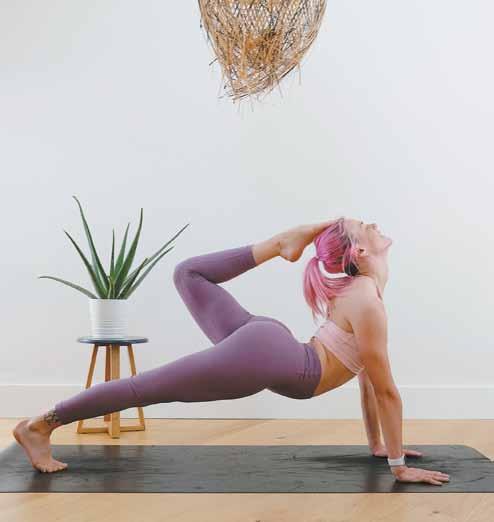
3 minute read
fit body

Contact us today to advertise in our next issue. 555-555-5555 Halting Hypertension
Advertisement

Exercises to Lower High Blood Pressure
by Marlaina Donato
An estimated 75 million American adults have blood pressure high enough to require management, according to the Centers for Disease Control and Prevention. For people with hypertension, tempering stress responses and limiting consumption of sodium, caffeine, alcohol and sugar can make a difference. Fortifying these lifestyle changes with aerobic exercise, yoga and high-intensity interval training (HIIT) can also help prevent and manage worrisome blood pressure readings.
Integrative cardiologist Jack Wolfson, in Paradise Valley, Arizona, points out that the development of hypertension is multicausal. “We are not genetically programmed to develop high blood pressure. Studies over the last 50 years confirm that physically active people have a lower risk of developing high blood pressure. For those with high blood pressure or people with a condition known as pre-hypertension, there is a blood pressurelowering effect of physical activity.”
Aside from the value of strength training, walking, cycling and jogging, the Mayo Clinic recommends everyday movement in the form of household chores such as raking leaves, tending a garden or pushing a lawnmower. Cross-country skiing, skating and swimming also pack an aerobic punch. Experts agree that an active lifestyle strengthens the heart, demanding less systemic effort to pump blood, and healthier blood pressure is a result.
“It’s been fascinating to watch clients come in extremely anxious about their high blood pressure number. A few months after consistent training and maintaining a healthier diet, there is a significant change within the body,” says Los Angeles fitness trainer Dominic Kennedy, creator of the new wellness app Dominic Effect. Kennedy recommends beginning with a brisk walk outside or on the treadmill and according to comfort level, bumping up the time each day. He underscores weights for those ready for strength training. “For many of my clients with high blood pressure, I superset their exercises so their heart rate is pumping. You will be surprised how aerobic weight training can be.”
Wolfson testifies to the benefits of HIIT, which alternates short periods of intense aerobic exercise with less intense recovery periods. “I recommend my patients get 30 minutes of HIIT four to five times per week. The design of a HIIT program must meet the person where they are at in their level of fitness. Whatever physical activity you choose, try to do it outside,” he says. “This way, we get the synergistic benefits of exercise and sunshine to lower your blood pressure. I’ve always told people that there is no such thing as bad weather, only bad clothes.”
yoga for Stress Management
Wolfson is also an advocate of yoga for its parasympathetic nervous system support. Research published in Journal of the American College of Cardiology in 2018 shows that yoga, breathwork and stretching all positively impact blood pressure, with the greatest improvements evident from yoga and deep breathing.
“Yoga, no matter the type, is known to promote a sense of calm in the body and mind. A regular practice will help to reduce the effects that stress causes. It may or may not be the only step necessary,” says New York City yoga instructor Gail Grossman, author of Restorative Yoga for Life. She emphasizes personal preferences and staying within your comfort zone, noting, “If you feel stressed because it’s difficult, it won’t benefit you. I personally think restorative yoga, breathwork and meditation are the best practices for high blood pressure.”
For Grossman, there is no such thing as too much yoga, but she recommends not getting overwhelmed with the commitment and having professional guidance for pranayama, or breathwork. “Do what you can. A practice does not have to be a full class, especially in restorative yoga. If you can commit to 20 minutes a day, you will see results, if you are consistent.”
Kennedy underscores that investment pays off. “Many clients have come to me months later when they are in a more normal range and say, ‘We wish we would have started this sooner in life,’ but it’s never too late to start a fitness program. A good personal trainer or coach will help you do it in a safe way and get your body back in shape and healthy.”
Marlaina Donato is an author and recording artist. Connect at AutumnEmbersMusic.com.












